

Greg and I agreed that we would stop by the Togian Islands, on the way up north. The story as we got close kept changing depending on who we talked to. The boat there seemed to run every other day. Not sure how this fits in with a seven day week. Anyway, the boat north, what? Once a week? Twice a week? No, you take a boat back to the south coast... huh? That doesn't make sense.
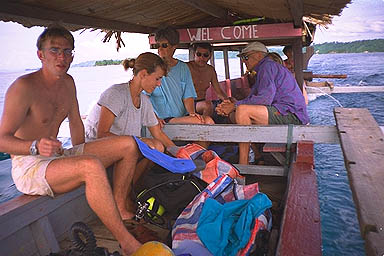
All transportation in the Togian islands is by way of longboats. These are boats that are fifty to a hundred feet long, but only a few feet wide. They have long arms that stretch to the sides and attach to the floaters. On each side of the boat there's one or a few long bamboo post used as a floater to keep the boat balanced upright. The bamboo instantly gives it a third world feel.
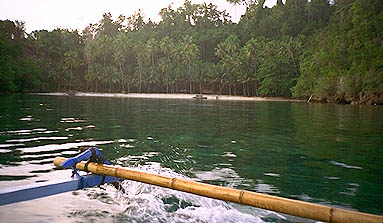
You get onto this boat either from a doc or directly from the beach. If it's the
beach, you'll get your feet wet. Hope you're wearing sandals and not shoes because
you pretty much have no choice in the matter. And it's salt water so you will soon
have to decide exactly how clean and sanitary you want to be and how much you just
let it go. It's far easier to let it go a little bit.
If you watch them dock, you'll be wondering, just how DO they do this in developed countries? Because there's simply GOT to be a better way. The ladder from the dock down to the boat is from rough-hewn wood and none of the rungs are level. We're talking lashings with rope, or maybe just a single nail, bam, through to hold the sticks together. And the boat is bobbing up and down. If you're a woman there's usually some man to help you. Just make sure you're not wearing high heel shoes; you'll need all the balance you can get. If you're a man, ahem, good luck. You'll look like a fool unless you are totally cool. Usually I ended up looking like a fool. No, I never fell in the water, and I didn't see anybody else fall in.
 The boat fills up with people and luggage; you sit on the left
or the right side. Sometimes there's actually benches to sit on. Usually there's
a roof over your head. Towards the back of the boat is a black area in the shadows,
and you can see that the engine is there, a big greasy machine.
The boat fills up with people and luggage; you sit on the left
or the right side. Sometimes there's actually benches to sit on. Usually there's
a roof over your head. Towards the back of the boat is a black area in the shadows,
and you can see that the engine is there, a big greasy machine.
Then you're there and the indonesian guys are there, trying to tell you something. Huh? What? To the other side? If there's an English speaker there you learn quickly: in order to balance the boat they have to have about half the people on the left and half the people on the right. Depending on where the luggage and everything else balances. So you get over and the boat can go on.
The guy in the front of the boat on the dock, he unties the boat and jumps on. He takes a big long pole, and pushes the boat away from the dock, Tom Sawyer style. Now the two guys in the engine area start moving. One goes to the front of the engine and reaches down to a small metal cap. It looks like the kind you'd put on the end of a pipe to make a dead end out of it. He screws it off and takes it off. Then he reaches down and grabs this zig zag piece of metal. He sticks one end into the engine, in that hole. It's a crank. Then, with his whole body, he lifts the crank and turns it. Kerum. He turns it around again. Kerum ahum. He lifts it again and the engine starts to cough. A few more cranks and starts sputtering into action.
It's not an impressive engine. It's a spewing diesel engine, with a pipe that sticks straight out to the side for the exhaust. I've seen some of them that don't even have an exhaust pipe; the exhaust comes right out of the engine to engulf the whole back end of the boat and its hapless indonesian caretakers in a cloud of black smoke.
Is it... safe? Three years after this trip, I got this email from a Frenchman who visited the same place:
Date: Fri, 28 Jul 2000 15:00:24 +0200 From: Olivier Pascal <Pascal.Olivier@wanadoo.fr> X-Accept-Language: fr Subject: Paradise is hell ! Hi I just come back from sulawesi and your site was very hepfull and I thank you for the informations. I just want to tell you something about Paradise Bungalows in Togian island because we had very big problems with the owner called Huntje. We were 9 tourists and we asked her to charter a regular safety boat from Wakai to Marisa. Paradise was just supposed to make the link with the Wakai's boat. Finaly she wanted to kept the money and we discover the morning we were supposed to leave that she gave us a small diving boat from the diving club' Paradise wich is not able to go for a 7 hours trip. We accepted because some of us had a fligh to take in Manado and they told us that the boat was safety enough. After 4 or 5 hours trip the boat begun to break and we had just enough time to go closer to the coast (close to Timur village). And finaly we sank.We swam to the coast wich was about 500 m from the boat . If it has happened 1/2 hours before we would have die (9 tourists and 5 indonesiens). Because of the cupidity and irresponsability of Paradise's owner 14 people lives were seriously in danger. I don't want it happened again. That is the reason why I want to tell to every body (they were articles in Manado and Jakarta news papers) and I send e-mail to traveller sites. If you can put this information in your site it would be very kind and helpfull for other travellers. Thank you Pascal If you need any more information don't hesitate !
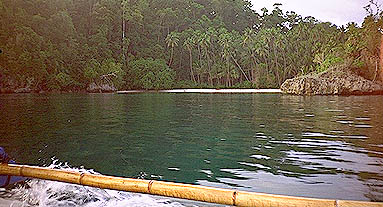 The islands are made of old coral. Almost all of the coastline
of all the islands is rocky coral. From a distance you see these islands, and the
shoreline for the most part is a coral cliff several feet high, as you see on the
edges of this photo.
The islands are made of old coral. Almost all of the coastline
of all the islands is rocky coral. From a distance you see these islands, and the
shoreline for the most part is a coral cliff several feet high, as you see on the
edges of this photo.
Occasionally, like maybe 5% of all coastline, there is a place where the ocean waves have battered coral into white powder, all washed up forming a white sand beach. My "hotel" was on one of the larger of such beaches.
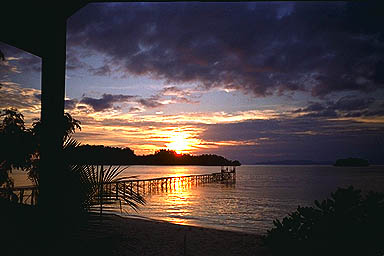
Every day I would come back from scuba diving or whatever and I'd take my daily shit and bath, and I'd have an hour or two as the sun set, to sit and enjoy it.
Sometimes I'd just write a postcard (that wasn't going to get mailed until I got back to civilization). Sometimes I'd take pictures of the sunset. These are the best of the sunset pictures.
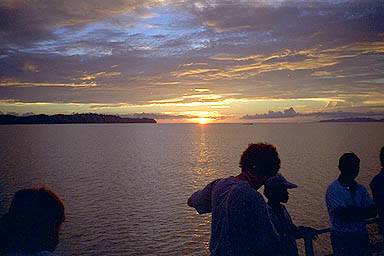
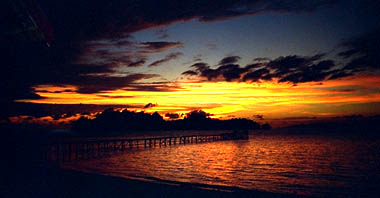
I remember when I got my Scuba certification, years before in California. They took us to the Monterey coast, a few hours south of San Francisco. It was the hardest scuba diving I had ever done, and the hardest I've done since.
You wrestle with your wetsuit to get it on. You wrestle to get the tank on. You wrestle to get the fins on. You walk around backwards with all this stuff on, teetering under the weight of the tank, rubber tubes encircling your upper body, then you get into the water. The waves are overwhelming, and you're already having trouble just standing up. And once you get down there, there's nothing to see but sand, a few fish and some seaweed. (Well ok, I did see a duck. Once. Swimming by really fast.)
You see there's little or no coral off the coast of California. Diving off Monterey is mostly for the scuba addicts who simply have to go down this weekend and can't wait to travel.
If it wasn't for coral reefs, the sport of Scuba Diving would be 1/20 of the size that it is today. Beyond the initial thrill of getting underwater, and messing with the equipment, there usually isn't a whole lot to see.
Coral reefs are different. The first thing you see are what looks like a garden full of drab plants, surrounded by colorful fish. On closer examination, the "plants" are really rigid formations, and they are really colorful. They look like big flowering bushes or flowers or leaves or mosses, but you notice that they are pretty much not moving, and if you lay a finger on them you realize they are essentially rock hard, and a bit fragile. The fingers of the "plants" are made of calcium carbonate, pretty much chalk. The outer surface is the only part that's colored.
The outer surface of the coral is also very rough; hard and rough like it's coated with sandpaper. So you don't want to touch it a lot. Otherwise it's easy to get scraped on the tips of your fingers pretty badly.
And the fish are really fun because there's a lot of them and lots of different kinds; the longer you stay there and look, the more different kinds you see. And you're swimming around amongst them; you see a huge school of pretty yellow fish just swimming in front of you, and sometimes you find yourself in the middle of them. They're close enough to grab, but you can't grab them because they swim away when you try. But other than that they aren't too afraid of you.
[Drat! I didn't have an underwater camera when I was there. But I did at Tulamben, which also had coral. ]
And if you look at the coral enough, you see more and more and more different kinds. And you realize that it's not all rigid, some of them are really moving. Really its an incredible diversity of life.
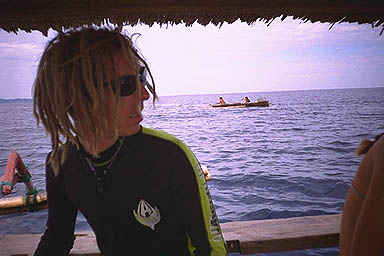 One night Paul, the diving instructor, took out this book he
had. Field Guide to Coral Reefs. Beautiful color pictures. Some customer at the island
had gone diving and couldn't pay, so he gave them this book instead.
One night Paul, the diving instructor, took out this book he
had. Field Guide to Coral Reefs. Beautiful color pictures. Some customer at the island
had gone diving and couldn't pay, so he gave them this book instead.
Paul was very possessive about this book. He said that any time he lent it out to someone, they "trashed" the book. How could that possibly happen. It's a book. What can go wrong? Gosh, so over-cautious. So he let us look at it in the dining hall area, but we couldn't take it back with us to our cabins.
The book was divided up into 25 chapters; each one was a different category of lifeform. Fish? There was one chapter on fish. One category. There were two categories of coral: soft coral and hard coral.
OK, that's just three categories. The book had 25 categories of living things, remember. 22 categories of life form to go. It was then that I realized just how diverse coral reefs were.
There were chapters on plants, sponges, starfish, crustatians, algae, clams, worms, mammals. There were chapters on single-celled animals. There were chapters on microscopic creatures that had been incorporated into the bodies of coral animals, right into their cells, a life-long symboitic relationship on a cellular level. I can't remember the details and I could barely understand what they were talking about sometimes. But it was amazing.
I was getting to be a good customer of the dive company they had there, and I kept on begging Paul, so one night he let me borrow it. And sure enough as soon as I had it, I was surrounded by other travelers, in some cases trying to grab it away. These were mostly Europeans they had there; french, dutch, german, danish. Suddenly I found myself getting very possessive about it, not letting anybody else touch it. So this is how it happens.
When you have it for a few minutes, you page through and look at the pictures. I wanted to read it cover to cover. I took it back to my bungalo. I didn't get to read the whole thing but I got quite a ways. It is mostly pictures after all.
I learned a lot that is totally unintuitive about how different life forms look. Clams don't look like clams. The clams are embedded entirely in the coral and all you see are a pair of big blue lips, and when you get close, the lips retract into their slot, the inside of which is the clamshell. These clamshells never close the way we think of clamshells closing.
When you're looking at coral, you sometimes see places where there's a handful of pretty tiny flowers. Tiny. Very colorful. Well, that's what they look like. Different colors, blossoms right sitting on the surface of a piece of otherwise somewhat smooth coral. Then you move your hand close, and ZIP! they all suck themselves into the coral and they're gone. Well, these I learned are "worms". I never would have guessed. The worms burrow into the hard coral, and this is what sticks out.
I learned what a polyp was. Probably I was supposed to have learned it in Biology but I didn't. A polyp is an animal that has a bag that is its stomach, and tentacles surrounding its mouth to shove food in. It digests the food and then spits out what's left. Very simple lifeform.
An octopus is a polyp. A squid is a polyp. And I learned that really coral are polyps. If you look carefully at coral, you'll notice that the surface is covered with little holes, little pockmarks almost like a golf ball. These are the mouths of all of these polyps. Other than that, the coral oozes this calcium stuff from the outsides of their bodies. That's what makes the coral rock itself. The structures come about because of the particular ways in which the polyps construct the calcium. There's so much variety it's incredible.
I read the book until really late. Hey, I don't have to get up to go to work tomorrow or anything. The book slid off the bed and I went to sleep.
I woke up to a commotion. It was storming out. The wind was blowing hard and it was raining. Well, this is the tropics, this sort of thing happens. I got out of bed to see out the window. It was blowing REALLY hard - the kind where you start to fear for the building you live in. With these flimsy shacks, I started to get worried. But what was really strange was that it started to drizzle in my bungalo - right inside! You know these structures are designed so that the wind can blow right through them - this is the tropics. The triangle part of the A-frame roof was pretty much open air. Well the wind was blowing so hard that it was carrying rain droplets right inside and it was sprinkling lightly right in my living space. The Book!!! I panicked. Paul said that every time he lends it out it gets trashed - and of all the nights here I am, and and it's raining inside my bungalo.
Fortunately I had a store of plastic bags I've been packratting away. I grabbed a bunch of them and wrapped the book in two layers of plastic bag. Then I looked around the room for anything else that would be ruined by moisture and I wrapped them up too. (As usual my room was a mess.)
By morning the storm was gone, the skys were sunny again and everything was OK. The book had gotten a little bit damp on one edge but it dried out easily. I got it back to Paul as soon as I could find him.
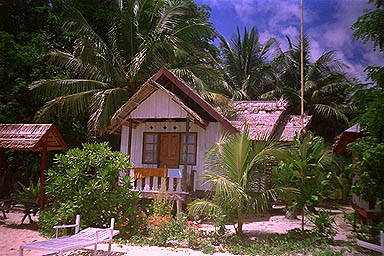
In many ways, living on Kadidiri Island was paradise. Life is simple and you spend the day doing snorkeling or scuba diving. Your meals are taken care of. European travelers are there to talk to, with all sorts of stories, and most of them speak decent English.
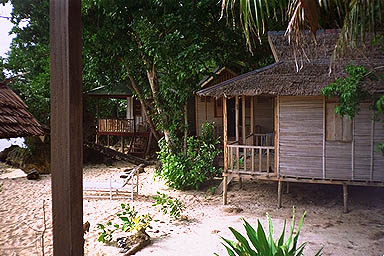 But in other ways it sucked. There was no electricity in the
rooms, no telephone, and heavens, no television or computers. Food was very simple,
you were to a large extent living off the land along with the indonesians. Sanitation
depended on their dubious freshwater, although you spent a few hours each day in
the sea.
But in other ways it sucked. There was no electricity in the
rooms, no telephone, and heavens, no television or computers. Food was very simple,
you were to a large extent living off the land along with the indonesians. Sanitation
depended on their dubious freshwater, although you spent a few hours each day in
the sea.
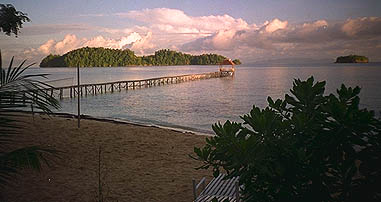 Not for the squeamish. About 30% to 40% of the travelers there
were women, almost always in the form of a couple. The rest of the travelers were
either pairs of men or isolated men. (Come to think of it, I showed up with Greg,
and he left part way through.) The one exception was one group that was two women
and a man, from Australia. The man was with one of the women; they were identical
twins so it was always hard to tell which.
Not for the squeamish. About 30% to 40% of the travelers there
were women, almost always in the form of a couple. The rest of the travelers were
either pairs of men or isolated men. (Come to think of it, I showed up with Greg,
and he left part way through.) The one exception was one group that was two women
and a man, from Australia. The man was with one of the women; they were identical
twins so it was always hard to tell which.

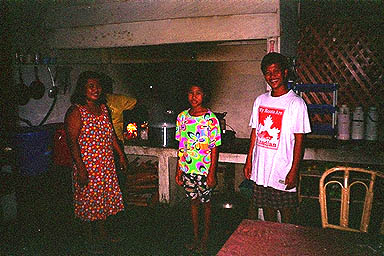 In the kitchen.
In the kitchen.
The guy in the red teeshirt is the manager of the hotel. His shirt says "My roots are Canadian". I just had to take the picture.
No, neither he nor any of the indonesians on the island has ever been to canada, or probably outside of the Sulawesi island area. They're all comparatively very poor. And it's kindof bad form to ask them if they've ever been to here or there. The hotel itself was one of a few such hotels, and they were associated with a hotel on Wakai, and the whole thing was owned by some Chinese investors in Singapore or Malaysia.
When I initially came over on the boat with Greg and a handful of other travelers, the boat also had on it three large plastic barrels of freshwater, and three live chickens, with their legs tied together. We had chicken for dinner that night. (They don't have refrigeration, of course, so this is how you transport chicken.)
Three meals a day were served in the dining room. "Room". It didn't have walls, just a platform and a roof with railings on the sides and a step up on two sides. Everybody shows up at... that time, I dunno, clocks didn't matter. They sit down at the tables and wait to be served.
Dinner consisted of:
There was beer. For 5000rp, you could get a large Bintang. I was running low on liquid cash, so I often opted for a cheaper Arak. For only 3500rp, you could get a Bintang bottle filled with Arak, the local rocket fuel. Total alcohol dosage was about double a Bintang, so it was a "good deal". Hey, I already know too many programming languages, so if I lose a few, it's OK. But, it sortof tasted like a badly-done mixed drink. You sortof end up wincing every time you take a gulp, and you try to get as much down as possible on each gulp. Usually one bottle was enough for the evening as you sit around telling stories with the other tourists under the only electric lights available in the whole place.
Lunch was similar to dinner. Breakfast was usually banana pancakes; you could buy a jar of jam and share it with your friends if you wanted, but I never had the cash for that.
The bathrooms were small concrete buildings with two rooms. The first room was a traditional mandi. When I first got there I tried to take a bath in this mandi. I put shampoo in my hair and tried to lather it up with some water. But it just wouldn't lather. Couldn't figure it out. Out of the corner of my mouth I tasted some salt - the water was saltwater! When you go to the bathroom, you go in the first room, with the squat toilet and the salt water.
To take a bath, you go in the second room. It had just a large tub of freshwater, and a floor that drained out. After swimming all day, you come here to rinse off. Add some shampoo and soap and you feel ready for dinner.
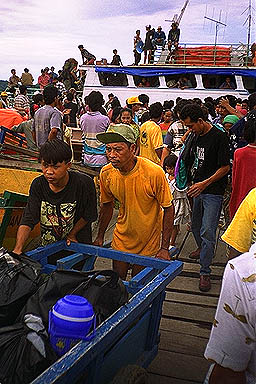 The "main town" for the Togian islands was Wakai.
Once, in the middle of my stay on Kadidiri, I went in to Wakai, I thought I would
go to a bank, buy some water at a cheap price, get some thongs, make a phone call
back to the states, see off Greg and some other friends as they took the boat north.
I ended up getting the water and watching the boat leave.
The "main town" for the Togian islands was Wakai.
Once, in the middle of my stay on Kadidiri, I went in to Wakai, I thought I would
go to a bank, buy some water at a cheap price, get some thongs, make a phone call
back to the states, see off Greg and some other friends as they took the boat north.
I ended up getting the water and watching the boat leave.
The hotel on Wakai was owned by the same people who owned the main hotel on Kadidiri. It was on the water and had its own dock. If you want to go to Wakai, you talk to the guy with the Canadian shirt, he speaks english. Well, a little english. There's usually a boat once or three times a day, whatever. It brings you to the hotel on Wakai. Since I had to take the same boat back later that day, that was my base of operations sortof. So I went shopping, and brought back my water bottles to the hotel.
The telephone place was reputed to be... in different places in town. Usually you go to the largest hotel. Good bet. I was there already. No phones. Go down, down this road here. It's down there. I left my bottles in the Wakai hotel, with Greg and the other guys who were going north.
OK well there's this place with antenna dishes out front but other than that... you mean that's it? They need all this stuff for the phone? The locals seemed to say that this was in fact the "telephone", an office with dishes pointed up at the sky. But it's Tutup, closed. When's it open? Dimana... no that's where. I forgot what I said. "Empat". Four. Four o'clock, that's right about when the boat goes back to Kadidiri. Well, it's a long boat, they won't leave without me.
I went back at four o'clock. Oh no, tutup, it's still closed. When's it open? "Malam". Evening. Here's the only telephone in the whole chain of islands and it's only open after my boat leaves. I gave up on the phone.
"Meesta! You get on boat!" This little kid in the street was trying to tell me to get on the boat. Go away kid. No I'm not getting on the boat to gorontalo, I'm staying here. My friends are already on the boat. Go away kid. Well, it turned out that the kid was from the hotel. My long boat was leaving and I better get back. So I got back to the hotel dock.
I got back and the boat hadn't left yet, but that wasn't the problem. My water was missing. The only thing that I'd gotten done in the whole afternoon of fooling around and now it was lost. Oh, soddy mista... the bag was right here, with all the luggage for all of the people taking the boat to Gorontalo. The hotel people thought it was part of the luggage that was going with them.
So, this is goofy, we all got on the long boat on the hotel dock. They drove the boat to the main dock, where the Gorontalo boat was, it hadn't taken off yet. They pulled right up to the boat itself. There was another boat next to it, these guys nestled the nose of the boat sortof alongside or inbetween them. Some kids climbed off our boat, onto the neighboring boat, and disappeared. After about five minutes, they came back with my bag of water bottles. Day saved. Went back to Kadidiri that nite, with water bottles. What a struggle.
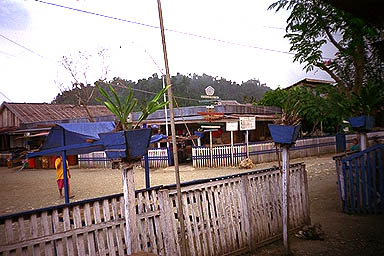
I had a financial problem while I was on the island. It seems that the last place to get cash was Poso, a town Greg and I had spent about an hour and a half in. I thought I had had enough cash, but Greg went to a bank. Little did I realize I would go for the next two weeks with no source of cash at all.
There were no banks in Wakai, the big town (and certainly no banks on Kadidiri Island where I was staying). Absolutely no way to change money. Even the local merchants in Wakai wouldn't take US currency; what could they do with it? This was pretty remote.
Going back to Poso would have been two or three days of travel. Just to get cash. Not to mention the travel expenses along the way, just to see boring towns that I'd already seen. It was out of the question.
When I got to the island and I realized the predicament I was in, I scraped up all the cash I had, going through my pack and wallet to find hidden envelopes of emergency cash and what not. I met an American who had been working for Apple in Singapore, and he was going back to the US and had extra Rupiah so we exchanged some twenties for local bills. I had been keeping some emergency US currency, some twenties and some smaller bills, but I had already had to use some of this so it was getting thin. But you know twenty dollars was like 50,000 rupiah; the absolute amount of money was irrelevant here. He told me that a lot of my US twenties were dirty and wrinkled and weren't good around here anyway, but he took them anyway and gave me a quite reasonable exchange rate.
I remember managing to scrape together a little over 200,000 rupiah. Sounds like a lot, but room and board cost 17,500rp per day, and I was going to stay here for nine days. Plus water and alcohol and other expenses, it was tight. That left very little for luxuries like jam or beer or scuba diving. I figured it was good for me to live under financial constraints for a change.
Initially I decided I simply couldn't afford to scuba dive. But it turns out that so many travelers get stuck in that bind that the dive place extended credit. So I ended up going on about six dives, and racking up a bill of, as I remember it, 305,000rp that I sent them later. If it wasn't for that I would have gotten bored really quickly. The dives really only cost us$20 apiece, so cheap that you really feel obligated to send them the money.
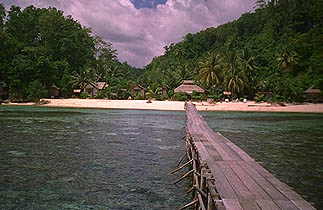 The freshwater was a bit mysterious. Of course we drank bottled
water that was beyond question; each bottle had a plastic seal on it, no problem
there. They charged 2,250rp for each bottle and I went through about one a day.
The freshwater was a bit mysterious. Of course we drank bottled
water that was beyond question; each bottle had a plastic seal on it, no problem
there. They charged 2,250rp for each bottle and I went through about one a day.
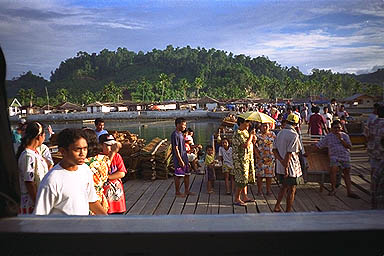 After my nine days, I got on the boat going north and took
it to Gorontalo.
After my nine days, I got on the boat going north and took
it to Gorontalo.
| this Story (home) | Allan in Southeast Asia (home) | Allan's website (home) | Next-> |
|---|